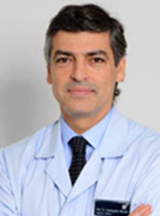João Espregueira-Mendes, MD, PhD, is the chairman of Clínica do Dragão at the Espregueira-Mendes Sports Centre, a FIFA Medical Centre of Excellence at the FC Porto Stadium. Espregueira-Mendes is also chairman and professor of orthopaedic sports medicine in the orthopaedic department of Minho University. He sits on several boards for foundations and educational institutions devoted to orthopaedic surgery and sports traumatology.
The Clínica do Dragão – Espregueira-Mendes Sports Centre is located in the FC Porto stadium and covers 2,000-square meters of space. Its activities include injury prevention and rehabilitation.
This article is part of our continuing series to raise awareness of the unmet needs in postoperative pain management (POPM) and to develop solutions that improve POPM across Europe. The opinions expressed in this interview are meant as an informal conversation to facilitate dialogue.
To further discuss the opinions expressed in this article, engage on Twitter, Facebook and LinkedIn #painmanagement #changepain #POPM.
João Espregueira-Mendes comes from a rich heritage of medical discussion within his own family. His grandfather began a practice in orthopaedics in 1926, a specialty that has carried forward as the family career of choice more than 90 years later. Espregueira-Mendes has seven patents in the field and was delighted to share his insights about new practices and technologies and the business of pain management in creating advantages for hospitals in competitive markets.
Latest pain management techniques
A century of progress in pain treatment and chronic pain management has taught us that with every positive implication of pain pharmaceuticals, there are numerous collateral impacts to patients that must be closely monitored and weighed regarding the benefits to ensure the best outcome for each individual patient within their surgical context. This principle driver of the evolution of pain management is also impacted by public health and social and economic factors that have transgenerational effects, especially when dealing with pain that becomes chronic and treatments that become prolonged or addictive. These factors highlight the need for collaborative discussions by all medical professionals dealing with pain treatment to consistently improve techniques and technologies to manage pain and address the various factors that impact patients and society. Even in a competitive environment, industry, practitioners and facilities can work together to build best practices for clear dialogues that promote patient-centric solutions.
Beginning from this premise, Espregueira-Mendes points out that ongoing conversations have highlighted different techniques that continue to be researched and applied in a variety of settings. It is difficult to pin down single techniques that are the latest or most impactful as the field is ripe with research into a variety of new or groundbreaking methods. More than individual techniques in and of themselves, Espregueira-Mendes cites collaborative thinking around pain management by a cross-functional team implementing a pain plan for each patient and monitoring outcomes as the core of the most effective techniques to providing improvements in overall patient outcomes. For specific techniques, he mentions neuromodulation and tissue engineering and regenerative medicine (TERM) as areas of interest that may be of significant intrigue for hospitals looking for a competitive edge in their pain management programs.
Neuromodulation involves the administration or stimulation of treatments directly to target cells within the central and peripheral nervous systems. Espregueira-Mendes notes that the research is interesting not only for its pain-specific and patient-centered applications, but also because within the competitive pain management marketplace, the technique will be incorporated into a variety of medical devices. Hospitals that are on the cutting edge of the technology and best in harmony with industry partners manufacturing the devices will have the best competitive advantage by demonstrating the impact of the new technologies through improved patient results.
Neuromodulation has gone from using simple electrical stimulations of various nerve tissue to the development of implantable pumps that provide targeted pain relief for a variety of different conditions. Espregueira-Mendes finds neuromodulation especially exciting in its applications for the control and treatment of neuropathic pain. The broad variety of pain beyond even postsurgical applications also makes this new technique appealing for hospitals looking for a competitive advantage. We might see neuromodulation-based devices in the future to help in the treatment of cerebral palsy, multiple sclerosis and brain injuries, as well as other osteopathic and traumatology applications.
In addition to neuromodulation, Espregueira-Mendes refers to TERM as another procedure that is quickly evolving through collaborative dialogues and cross-functional research. He points out his own research collaboration with the 3B’s Research Group (conducted by Prof. Rui L. Reis) that is working on biomaterial research and development platforms to better develop therapeutic agents in regenerative medicine and drug delivery applications. He states, “From TERM, we may become able to address several conditions in orthopaedics and in sports medicine avoiding repair, substitution or other physically invasive surgical procedures that can be contributing for postoperative pain.”
The focus, then, in each of these promising factors (and the many others he implies are also under development) is a paradigm shift in orthopaedic surgery. This shift focuses even further on the prevention of pain not only through development of pain management processes, but also through techniques that move practitioners away from common surgical practices and the consequent pharmaceutical support required to manage postoperative pain. Where targeted stimulation treatments, such as neuromodulation and regeneration of various cells and tissue to manage the complications of surgery, including opioid treatments and the impacts of chronic pain and addiction, reduce the upfront causes of postoperative pain and some of the barriers that require dependency on opioid and other treatments with collateral consequences, postoperative pain management evolves with new procedures and technologies into preoperative pain avoidance planning. The safety and effectiveness of treatment options continues to progress. Of this potential paradigm shift, Espregueira-Mendes says, “Imagine having a slight pin prick on an old knee as a method to insert new cartilage that generates into a biological product that is as good as new.” Today’s reality is a saw and prosthetics, but the promise of today’s collaborations and further research are a step-change not only for pain management, but for the entirety of how we view surgical procedures themselves.
Espregueira-Mendes said those procedures he cites are only some of the promising new practices being developed. Other more specific processes, such as the use of osteochondral graft and other practices that have a more specific application, are promising even in their more detailed applications. What these techniques share, he stated, is a reliance on cross-collaboration between practitioners in all phases — preoperative, perioperative and postoperative – of the pain management timeline. Forward-thinking hospitals that will be competitive are those that promote strong pain management practices that are open to dialogue and research for finding the latest applications of the most efficient approaches for patient results.
Competitive hospitals
In his other comments about furthering the competitiveness of hospitals based on their pain management techniques, Espregueira-Mendes said the drivers and results of these practices vary among facilities dependent on which stakeholders take part in the evaluation process of the programs involved. It is also essential to underline that public hospitals will differ in their priorities from those of public–private partnerships and entirely private facilities. The mix of these varieties of facilities will vary from market to market across Europe, so there is no single approach to be applied broadly that can answer for all involved. When referring to the Portuguese context, Espregueira-Mendes said public hospitals rank opportunities for implementation of new practices and technologies based on demonstration of results in achieved in-hospital mortality, complications, readmissions, outpatient surgery numbers, time of internment, operating costs per patient, and the ratio of patients per practitioner (doctor, nurse, etc.).
In private facilities, measures of success in Portugal are often ascribed to patients’ perception of value, quality of service, communication with key stakeholders, bonding with doctors and nurses, and the overall humanity of the service. For new and emerging postoperative pain management techniques and technologies to appeal to the competitiveness of individuals who are actively involved in this area, those promoting them within their pain management practices need to focus on promoting a variety of these measures and demonstrating the good performance of the new procedure along these measures, which can be both objective and subjective measures but must always be clearly defined and supported by the evidence.
Systemisation of competitive benchmarking
In collaboration with a facility, researchers and practitioners can promote evidence-based results that have been subject to rigorous quality criteria and use them as marketing for the quality that a patient can expect from that facility. That said, Espregueira-Mendes said asymmetries already exist in pain management from one hospital to another and the approaches to evaluating pain management programs, training and practices. He underscores the need for systemisation and indexation of any measures to standard medical governance principles.
Overall, Europe is working on systemising quality and there is a lot of focus on patient-centeredness, which Espregueira-Mendes said is a good thing, a commonly shared positive factor across the continent. Despite the fact that quality, efficiency or performance are sometimes difficult to quantify in a systemic matter, the vast data available across Europe clearly show key factors that cause variations in those measures. He referred to productivity measures across National Health Service hospitals in the United Kingdom gleaned from the Health at a Glance series of reports and the Carter Review as signs of the positive impacts of arriving at systemic quality measures.
Practitioners involved in the development of new techniques or technologies should study those advances according to their impact on these common quality indicators.
“It brings an obvious path to understand how and why each country or hospital [performing the new technique] performs better in the indicator and allows us to extract that knowledge and promote it,” he said.
Promotion of new techniques and technologies in this way, from a basis of collaboration and common dialogue within pain management professionals, can have a stronger impact on key stakeholders, and the clarity of results will impact patient perceptions of service quality. The net results not only would be better outcomes for patients (avoiding analgesic gaps or achieving faster and superior pain control), but the promotion of better results overall due to these new practices will also be a driving factor for patients, insurers, regulators and other stakeholders to promote one hospital over another. Therefore, new innovations in pain management can be a competitive advantage for hospitals, but, as Espregueira-Mendes stated, they must begin by first installing a collaborative cross-functional pain management practice within the hospital and then develops that practice into promotion of the new innovations and technologies for patient-centered results.
For further reading:
- Pereira H, et al. Arthroscopy. 2011;doi:10.1016/j.arthro.2011.08.283.
- To understand more about the socio-economic and health-based indicators across Europe that drive competition in the market, he recommends Health at a Glance2017 to keep informed of changes and variations in the different OECD countries.
For more information:
As the platform organisation linking Europe’s national orthopaedic associations, the European Federation of National Associations of Orthopaedics and Traumatology partners with Grünenthal to raise further awareness of the unmet needs in postoperative pain management (POPM) and to develop solutions that improve POPM across Europe.
Over the next 6 months, we will involve pain experts from across Europe in interviews, debates and other discussions to generate a better understanding of physicians’ and patients’ perspectives. The goal of this series is to communicate best practices and increase discussion on POPM in general.
Burson-Marsteller, established in 1953, is a leading global public relations and communications firm, and the EFORT-mandated press agency for the POPM awareness campaign. All articles published herein respect the third-party content policy of EFORT as published on our website.
For any articles related inquiries, please contact media@efort.org.



